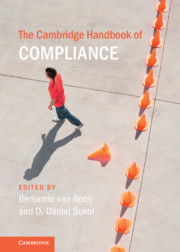Book contents
- The Cambridge Handbook of Compliance
- The Cambridge Handbook of Compliance
- Copyright page
- Contents
- Figures
- Tables
- Contributors
- 1 Introduction: Compliance as the Interaction between Rules and Behavior
- Part I Compliance Concepts and Approaches
- Part II Deterrence and Incapacitation
- 14 Deterrence Theory: Key Findings and Challenges
- 15 General Deterrence: Review with Commentary on Decision-Making
- 16 Incarceration and Crime
- 17 Corporate Crime Deterrence
- 18 Deterrence Perceptions
- 19 Reputational Effects of Noncompliance with Financial Market Regulations
- 20 Deterrability and Moral Judgment
- 21 US Debarment: An Introduction
- Part III Incentives
- Part IV Legitimacy and Social Norms
- Part V Capacity and Opportunity
- Part VI Compliance and Cognition
- Part VII Management and Organizational Processes
- Part VIII Measuring and Evaluating Compliance
- Part IX Analysis of Particular Fields
- References
17 - Corporate Crime Deterrence
from Part II - Deterrence and Incapacitation
Published online by Cambridge University Press: 07 May 2021
- The Cambridge Handbook of Compliance
- The Cambridge Handbook of Compliance
- Copyright page
- Contents
- Figures
- Tables
- Contributors
- 1 Introduction: Compliance as the Interaction between Rules and Behavior
- Part I Compliance Concepts and Approaches
- Part II Deterrence and Incapacitation
- 14 Deterrence Theory: Key Findings and Challenges
- 15 General Deterrence: Review with Commentary on Decision-Making
- 16 Incarceration and Crime
- 17 Corporate Crime Deterrence
- 18 Deterrence Perceptions
- 19 Reputational Effects of Noncompliance with Financial Market Regulations
- 20 Deterrability and Moral Judgment
- 21 US Debarment: An Introduction
- Part III Incentives
- Part IV Legitimacy and Social Norms
- Part V Capacity and Opportunity
- Part VI Compliance and Cognition
- Part VII Management and Organizational Processes
- Part VIII Measuring and Evaluating Compliance
- Part IX Analysis of Particular Fields
- References
Summary
Abstract: This chapter examines what is known about corporate crime deterrence in hopes of identifying legal strategies that can prevent such crimes and their often-immense harms against consumers, competitors, employees, creditors, and owners. In this chapter, we rely heavily on results from a meta-analytic study of corporate crime deterrence research but also examine the extant literature in an effort to summarize what formal mechanisms might be effective in promoting compliance. Despite increasing awareness of the frequency and consequences of these violations, research has produced almost no conclusive recommendations. We find that simply making new corporate crime laws is ineffective, while actual criminal justice sanctions (e.g., arrest, incarceration) seem to be inconsistently effective. There is some support for the use of fines and monetary sanctions (both civil and criminal) in producing compliance, but financial penalties seem to be effective only in the short term and only when they are very high. Furthermore, in our review, regulatory sanctions seem to be effective against individual-level offending, but these sanctions have wildly inconsistent impacts when leveled against corporations. We discuss the dire need for more research, offering specific suggestions for scholarship.
- Type
- Chapter
- Information
- The Cambridge Handbook of Compliance , pp. 219 - 235Publisher: Cambridge University PressPrint publication year: 2021
References
- 2
- Cited by

